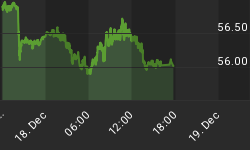Well, we are certainly living in interesting times, bearing in mind that this is said to be a Chinese curse. Consumer confidence is down even though consumer spending seems to be holding up month after month. The Dow Jones Industrial Average drops by223.55, sending out panic signals to numerous investors. Yet this fall amounted to only 1.69 per cent. We then get the news that productivity leapt to an annualised rate of 4.9 per cent in the July-September quarter while unit labour costs eased.
On top of this the last 49 consecutive months saw the US economy generating a record number of jobs and the GDP accelerate. How can all of this be when everyone knows there is a 'credit squeeze'? Moreover, a falling dollar is adding to 'inflation'. As we say in Australia: "We'll all be rooned?"
Taking consumer spending as our starting point we should be able to see why so many economic commentators keep getting it wrong. Frequent readers know that I keep pressing the point that it is business spending that drives the economy and not consumption. Once we take account of this fact one should be able to see that an economy can continue to accumulate capital and hence lay the groundwork for higher future living standards even as current consumption has declined. This is because it was the voluntary decline in consumption that made increased investment possible. It is -- as older economists would have put it -- a matter of proportion.
The jobs situation has got many commentators flummoxed. It shouldn't. There is no real trick to creating jobs so long as there is sufficient capital and land available to employ people. The real trick is to create jobs that keep on paying more. A trick that only the market can perform. This particular trick is called capital accumulation.
(All that is needed to destroy the job-creating process is another Hoover or Roosevelt. It was their policies that destroyed profits, investment incentives and kept wage rates above market clearing levels).
What about inflation caused by a falling dollar? There ain't no such animal. The Fed floods the world with dollars, and people are mystified because it depreciates. The very same people -- people who are paid to know better -- declared that the depreciation will be inflationary and will force the Fed to raise rates. This is a truly dreadful fallacy. It is self-evident why the dollar fell. It was driven down by inflation. Unfortunately a large number of people have firmly grabbed the wrong end of horse on this one. An economist from another age put explained that it is an
... illusion that in the long run devaluation can be avoided though no attempt is made to halt domestic inflation [monetary expansion]. (L. Albert Hahn, Squier Publishing Co., Inc. p. 173).
It must be admitted that the "illusion of nondevaluation" is nourished by the Bretton Woods Organization, which reinforces still further the strong tendency of our time to conceal rather than remove inflations. The International Monetary Fund is based on the illusion that nineteenth-century currency stability can be achieved, even approximately or for a time, in this twentieth-century world, a world in which the will and the ability to adjust domestic factors, which have become rigid according to the exchange rate, are no longer present. (Ibid. pp. 182-83)
In other words, it is domestic inflation that drove down the dollar. Those who argued that cheap imports "kept inflation under control" were oblivious to the fact that these imports were the result of the US 'exporting' its inflation in the form of excess dollars. The boast that the falling dollar is driving exports is itself based on an illusion. This is why currency dealers who think devaluations cause inflation can get badly burned. It may turn out that the dollar is now undervalued instead of overvalued. But this is the kind of conundrum that is inescapable in a world where paper currencies rule.
The so-called credit squeeze seems to be happening in the financial sector, at least that's where the complaints are coming from. Considering that the Fed has lowered the funds rate I can only conclude that some people are finding it increasingly difficult to close equity deals because the banks have become more cautious. This is not a squeeze but something they should have done long ago.
There are two types of credit squeezes: There is the obvious one where the Fed raises rates. Then there is the one that very people recognise, including most economists. When this one emerges it signals the impending end of a boom. Industry in the higher stages of production finds itself facing rising costs without any compensating increase in the prices of its products. In order to continue production firms have to compete with each other for more and more funds, driving up short term rates even though the central bank has kept rates steady. This is a very important signal and one that seems to be absent for the moment
So how will it all end? In tears, as always.
















